Target Information
| Target General Information | Top | |||||
|---|---|---|---|---|---|---|
| Target ID |
T58454
(Former ID: TTDS00171)
|
|||||
| Target Name |
Fibroblast growth factor receptor 2 (FGFR2)
|
|||||
| Synonyms |
Keratinocyte growth factor receptor 2; Keratinocyte growth factor receptor; KSAM; KGFR; K-sam; FGFR-2; FGF-2 receptor; CD332; BEK
Click to Show/Hide
|
|||||
| Gene Name |
FGFR2
|
|||||
| Target Type |
Successful target
|
[1] | ||||
| Disease | [+] 3 Target-related Diseases | + | ||||
| 1 | Hepatitis virus infection [ICD-11: 1E50-1E51] | |||||
| 2 | Liver cancer [ICD-11: 2C12] | |||||
| 3 | Oral mucositis [ICD-11: DA01] | |||||
| Function |
Required for normal embryonic patterning, trophoblast function, limb bud development, lung morphogenesis, osteogenesis and skin development. Plays an essential role in the regulation of osteoblast differentiation, proliferation and apoptosis, and is required for normal skeleton development. Promotes cell proliferation in keratinocytes and immature osteoblasts, but promotes apoptosis in differentiated osteoblasts. Phosphorylates PLCG1, FRS2 and PAK4. Ligand binding leads to the activation of several signaling cascades. Activation of PLCG1 leads to the production of the cellular signaling molecules diacylglycerol and inositol 1,4,5-trisphosphate. Phosphorylation of FRS2 triggers recruitment of GRB2, GAB1, PIK3R1 and SOS1, and mediates activation of RAS, MAPK1/ERK2, MAPK3/ERK1 and the MAP kinase signaling pathway, as well as of the AKT1 signaling pathway. FGFR2 signaling is down-regulated by ubiquitination, internalization and degradation. Mutations that lead to constitutive kinase activation or impair normal FGFR2 maturation, internalization and degradation lead to aberrant signaling. Over-expressed FGFR2 promotes activation of STAT1. Tyrosine-protein kinase that acts as cell-surface receptor for fibroblast growth factors and plays an essential role in the regulation of cell proliferation, differentiation, migration and apoptosis, and in the regulation of embryonic development.
Click to Show/Hide
|
|||||
| BioChemical Class |
Kinase
|
|||||
| UniProt ID | ||||||
| EC Number |
EC 2.7.10.1
|
|||||
| Sequence |
MVSWGRFICLVVVTMATLSLARPSFSLVEDTTLEPEEPPTKYQISQPEVYVAAPGESLEV
RCLLKDAAVISWTKDGVHLGPNNRTVLIGEYLQIKGATPRDSGLYACTASRTVDSETWYF MVNVTDAISSGDDEDDTDGAEDFVSENSNNKRAPYWTNTEKMEKRLHAVPAANTVKFRCP AGGNPMPTMRWLKNGKEFKQEHRIGGYKVRNQHWSLIMESVVPSDKGNYTCVVENEYGSI NHTYHLDVVERSPHRPILQAGLPANASTVVGGDVEFVCKVYSDAQPHIQWIKHVEKNGSK YGPDGLPYLKVLKAAGVNTTDKEIEVLYIRNVTFEDAGEYTCLAGNSIGISFHSAWLTVL PAPGREKEITASPDYLEIAIYCIGVFLIACMVVTVILCRMKNTTKKPDFSSQPAVHKLTK RIPLRRQVTVSAESSSSMNSNTPLVRITTRLSSTADTPMLAGVSEYELPEDPKWEFPRDK LTLGKPLGEGCFGQVVMAEAVGIDKDKPKEAVTVAVKMLKDDATEKDLSDLVSEMEMMKM IGKHKNIINLLGACTQDGPLYVIVEYASKGNLREYLRARRPPGMEYSYDINRVPEEQMTF KDLVSCTYQLARGMEYLASQKCIHRDLAARNVLVTENNVMKIADFGLARDINNIDYYKKT TNGRLPVKWMAPEALFDRVYTHQSDVWSFGVLMWEIFTLGGSPYPGIPVEELFKLLKEGH RMDKPANCTNELYMMMRDCWHAVPSQRPTFKQLVEDLDRILTLTTNEEYLDLSQPLEQYS PSYPDTRSSCSSGDDSVFSPDPMPYEPCLPQYPHINGSVKT Click to Show/Hide
|
|||||
| 3D Structure | Click to Show 3D Structure of This Target | AlphaFold | ||||
| HIT2.0 ID | T22JG3 | |||||
| Drugs and Modes of Action | Top | |||||
|---|---|---|---|---|---|---|
| Approved Drug(s) | [+] 3 Approved Drugs | + | ||||
| 1 | Interferon Alfa-2a, Recombinant | Drug Info | Approved | Chronic HCV-1 infection | [2] | |
| 2 | Palifermin | Drug Info | Approved | Oral mucositis | [3], [4] | |
| 3 | Pemigatinib | Drug Info | Approved | Cholangiocarcinoma | [5] | |
| Clinical Trial Drug(s) | [+] 9 Clinical Trial Drugs | + | ||||
| 1 | E-3810 | Drug Info | Phase 3 | Solid tumour/cancer | [6], [7] | |
| 2 | Trafermin | Drug Info | Phase 3 | Periodontitis | [8] | |
| 3 | Debio 1347 | Drug Info | Phase 2 | Solid tumour/cancer | [9] | |
| 4 | LY2874455 | Drug Info | Phase 2 | Solid tumour/cancer | [10], [11] | |
| 5 | AEE-788 | Drug Info | Phase 1/2 | Solid tumour/cancer | [12], [13] | |
| 6 | MK-2461 | Drug Info | Phase 1/2 | Alzheimer disease | [14] | |
| 7 | Alofanib | Drug Info | Phase 1 | Gastric adenocarcinoma | [15] | |
| 8 | BAY1179470 | Drug Info | Phase 1 | Solid tumour/cancer | [16] | |
| 9 | RLY-4008 | Drug Info | Phase 1 | Solid tumour/cancer | [17] | |
| Discontinued Drug(s) | [+] 1 Discontinued Drugs | + | ||||
| 1 | PD-0183812 | Drug Info | Terminated | Retinoblastoma | [18] | |
| Mode of Action | [+] 5 Modes of Action | + | ||||
| Binder | [+] 3 Binder drugs | + | ||||
| 1 | Interferon Alfa-2a, Recombinant | Drug Info | [19] | |||
| 2 | Palifermin | Drug Info | [1] | |||
| 3 | PK 11195 | Drug Info | [19] | |||
| Inhibitor | [+] 12 Inhibitor drugs | + | ||||
| 1 | Pemigatinib | Drug Info | [5] | |||
| 2 | E-3810 | Drug Info | [20] | |||
| 3 | Debio 1347 | Drug Info | [21] | |||
| 4 | AEE-788 | Drug Info | [23] | |||
| 5 | MK-2461 | Drug Info | [14] | |||
| 6 | Alofanib | Drug Info | [24] | |||
| 7 | RLY-4008 | Drug Info | [26] | |||
| 8 | PD-0183812 | Drug Info | [27] | |||
| 9 | ACTB-1003 | Drug Info | [28] | |||
| 10 | Platelet factor 4 (PF-4) | Drug Info | [29] | |||
| 11 | Ro-4396686 | Drug Info | [30] | |||
| 12 | TG-100435 | Drug Info | [31] | |||
| Activator | [+] 1 Activator drugs | + | ||||
| 1 | Trafermin | Drug Info | [8] | |||
| Modulator | [+] 1 Modulator drugs | + | ||||
| 1 | LY2874455 | Drug Info | [22] | |||
| Antagonist | [+] 1 Antagonist drugs | + | ||||
| 1 | BAY1179470 | Drug Info | [25] | |||
| Cell-based Target Expression Variations | Top | |||||
|---|---|---|---|---|---|---|
| Cell-based Target Expression Variations | ||||||
| Drug Binding Sites of Target | Top | |||||
|---|---|---|---|---|---|---|
| Ligand Name: L-betagamma-meATP | Ligand Info | |||||
| Structure Description | Crystal Structure of Tyrosine Phosphorylated Activated FGF Receptor 2 (FGFR2) Kinase Domain in Complex with ATP Analog and Substrate Peptide | PDB:2PVF | ||||
| Method | X-ray diffraction | Resolution | 1.80 Å | Mutation | Yes | [32] |
| PDB Sequence |
ELPEDPKWEF
476 PRDKLTLGKP486 LGEGAFGQVV496 MAEAVGIDKD506 KPVTVAVKML519 KDDATEKDLS 529 DLVSEMEMMK539 MIGKHKNIIN549 LLGACTQDGP559 LYVIVEYASK569 GNLREYLRAR 579 RPPGMESYQM598 TFKDLVSCTY608 QLARGMEYLA618 SQKCIHRDLA628 ARNVLVTENN 638 VMKIADFGLA648 RDINNIDKKT660 TNGRLPVKWM670 APEALFDRVY680 THQSDVWSFG 690 VLMWEIFTLG700 GSPYPGIPVE710 ELFKLLKEGH720 RMDKPANCTN730 ELYMMMRDCW 740 HAVPSQRPTF750 KQLVEDLDRI760 LTLTT
|
|||||
|
|
LEU487
3.596
GLY488
3.529
GLU489
4.775
GLY490
2.957
ALA491
3.172
PHE492
3.007
GLY493
2.971
VAL495
3.641
ALA515
3.269
LYS517
2.715
GLU534
4.836
ILE548
4.418
|
|||||
| Click to View More Binding Site Information of This Target and Ligand Pair | ||||||
| Ligand Name: Phosphonotyrosine | Ligand Info | |||||
| Structure Description | Crystal Structure of Tyrosine Phosphorylated Activated FGF Receptor 2 (FGFR2) Kinase Domain in Complex with ATP Analog and Substrate Peptide | PDB:2PVF | ||||
| Method | X-ray diffraction | Resolution | 1.80 Å | Mutation | Yes | [32] |
| PDB Sequence |
ELPEDPKWEF
476 PRDKLTLGKP486 LGEGAFGQVV496 MAEAVGIDKD506 KPVTVAVKML519 KDDATEKDLS 529 DLVSEMEMMK539 MIGKHKNIIN549 LLGACTQDGP559 LYVIVEYASK569 GNLREYLRAR 579 RPPGMESYQM598 TFKDLVSCTY608 QLARGMEYLA618 SQKCIHRDLA628 ARNVLVTENN 638 VMKIADFGLA648 RDINNIDKKT660 TNGRLPVKWM670 APEALFDRVY680 THQSDVWSFG 690 VLMWEIFTLG700 GSPYPGIPVE710 ELFKLLKEGH720 RMDKPANCTN730 ELYMMMRDCW 740 HAVPSQRPTF750 KQLVEDLDRI760 LTLTT
|
|||||
|
|
ARG573
4.967
ARG577
2.698
ARG580
3.731
MET584
3.420
GLU585
1.330
SER587
1.328
TYR588
4.811
ILE623
3.797
ARG625
3.342
ARG649
2.901
ILE651
3.805
|
|||||
| Click to View More Binding Site Information of This Target and Ligand Pair | ||||||
| Click to View More Binding Site Information of This Target with Different Ligands | ||||||
| Different Human System Profiles of Target | Top |
|---|---|
|
Human Similarity Proteins
of target is determined by comparing the sequence similarity of all human proteins with the target based on BLAST. The similarity proteins for a target are defined as the proteins with E-value < 0.005 and outside the protein families of the target.
A target that has fewer human similarity proteins outside its family is commonly regarded to possess a greater capacity to avoid undesired interactions and thus increase the possibility of finding successful drugs
(Brief Bioinform, 21: 649-662, 2020).
Human Tissue Distribution
of target is determined from a proteomics study that quantified more than 12,000 genes across 32 normal human tissues. Tissue Specificity (TS) score was used to define the enrichment of target across tissues.
The distribution of targets among different tissues or organs need to be taken into consideration when assessing the target druggability, as it is generally accepted that the wider the target distribution, the greater the concern over potential adverse effects
(Nat Rev Drug Discov, 20: 64-81, 2021).
Human Pathway Affiliation
of target is determined by the life-essential pathways provided on KEGG database. The target-affiliated pathways were defined based on the following two criteria (a) the pathways of the studied target should be life-essential for both healthy individuals and patients, and (b) the studied target should occupy an upstream position in the pathways and therefore had the ability to regulate biological function.
Targets involved in a fewer pathways have greater likelihood to be successfully developed, while those associated with more human pathways increase the chance of undesirable interferences with other human processes
(Pharmacol Rev, 58: 259-279, 2006).
Biological Network Descriptors
of target is determined based on a human protein-protein interactions (PPI) network consisting of 9,309 proteins and 52,713 PPIs, which were with a high confidence score of ≥ 0.95 collected from STRING database.
The network properties of targets based on protein-protein interactions (PPIs) have been widely adopted for the assessment of target’s druggability. Proteins with high node degree tend to have a high impact on network function through multiple interactions, while proteins with high betweenness centrality are regarded to be central for communication in interaction networks and regulate the flow of signaling information
(Front Pharmacol, 9, 1245, 2018;
Curr Opin Struct Biol. 44:134-142, 2017).
Human Similarity Proteins
Human Tissue Distribution
Human Pathway Affiliation
Biological Network Descriptors
|
|
|
Note:
If a protein has TS (tissue specficity) scores at least in one tissue >= 2.5, this protein is called tissue-enriched (including tissue-enriched-but-not-specific and tissue-specific). In the plots, the vertical lines are at thresholds 2.5 and 4.
|
| KEGG Pathway | Pathway ID | Affiliated Target | Pathway Map |
|---|---|---|---|
| MAPK signaling pathway | hsa04010 | Affiliated Target |
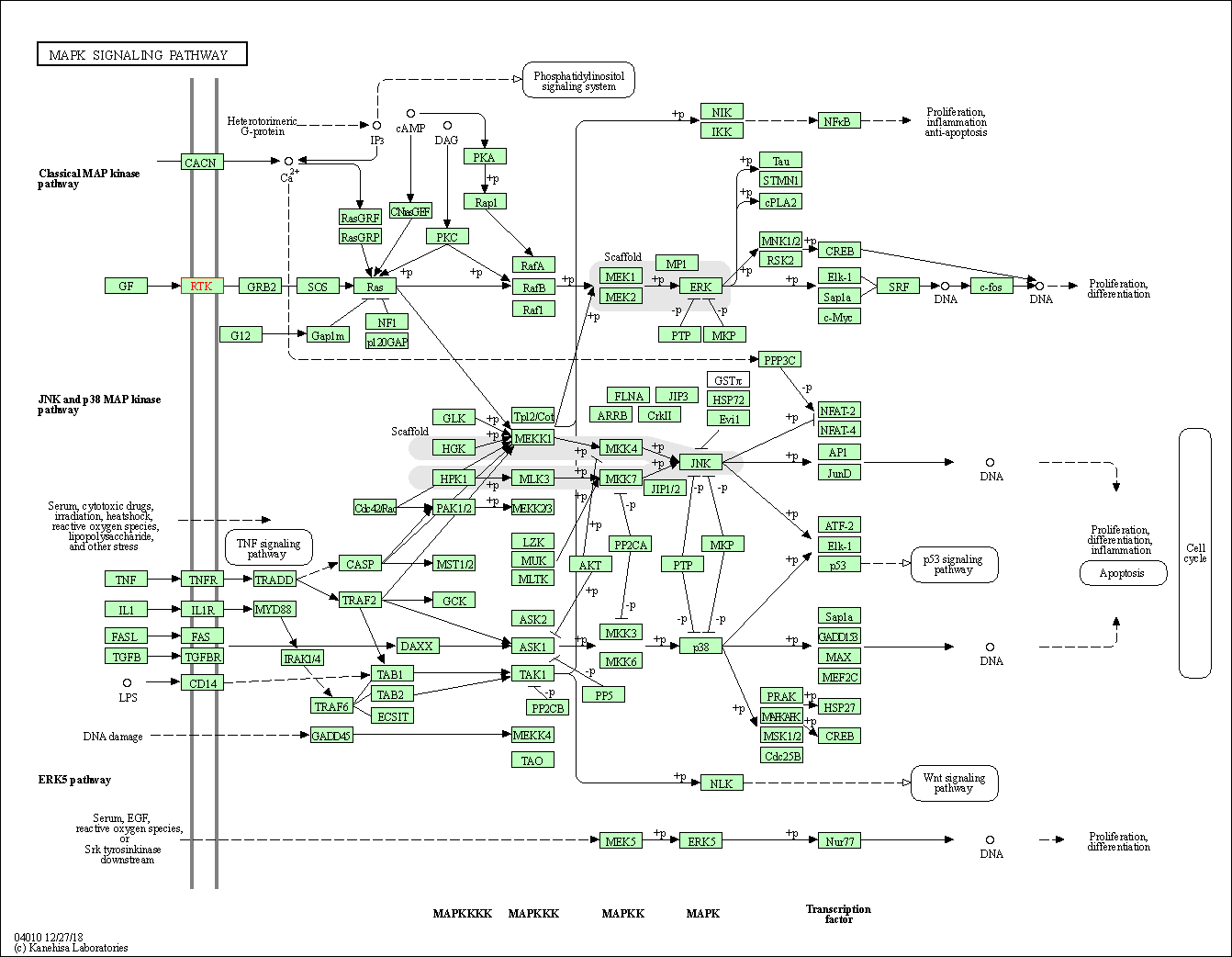
|
| Class: Environmental Information Processing => Signal transduction | Pathway Hierarchy | ||
| Ras signaling pathway | hsa04014 | Affiliated Target |
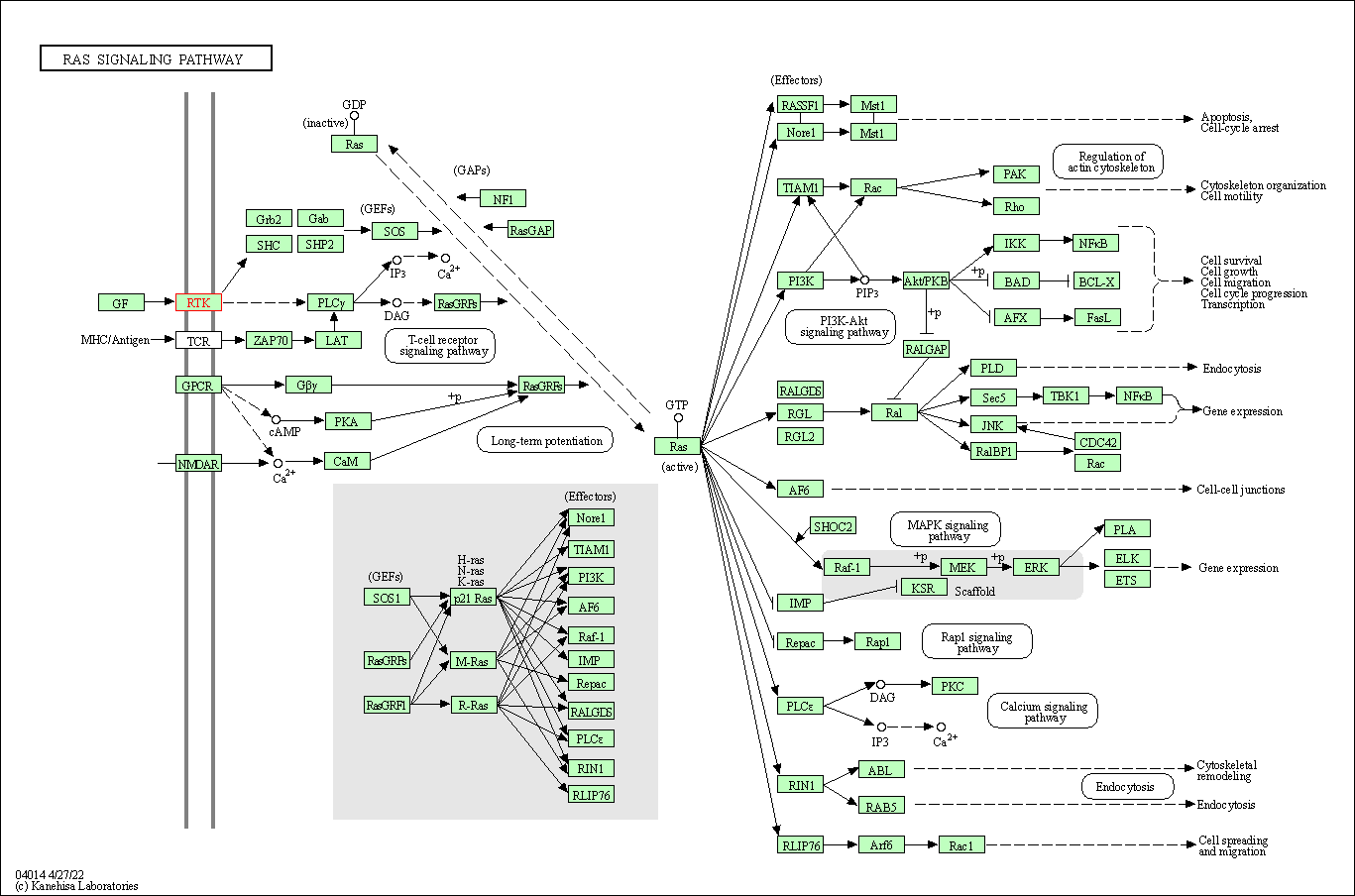
|
| Class: Environmental Information Processing => Signal transduction | Pathway Hierarchy | ||
| Rap1 signaling pathway | hsa04015 | Affiliated Target |
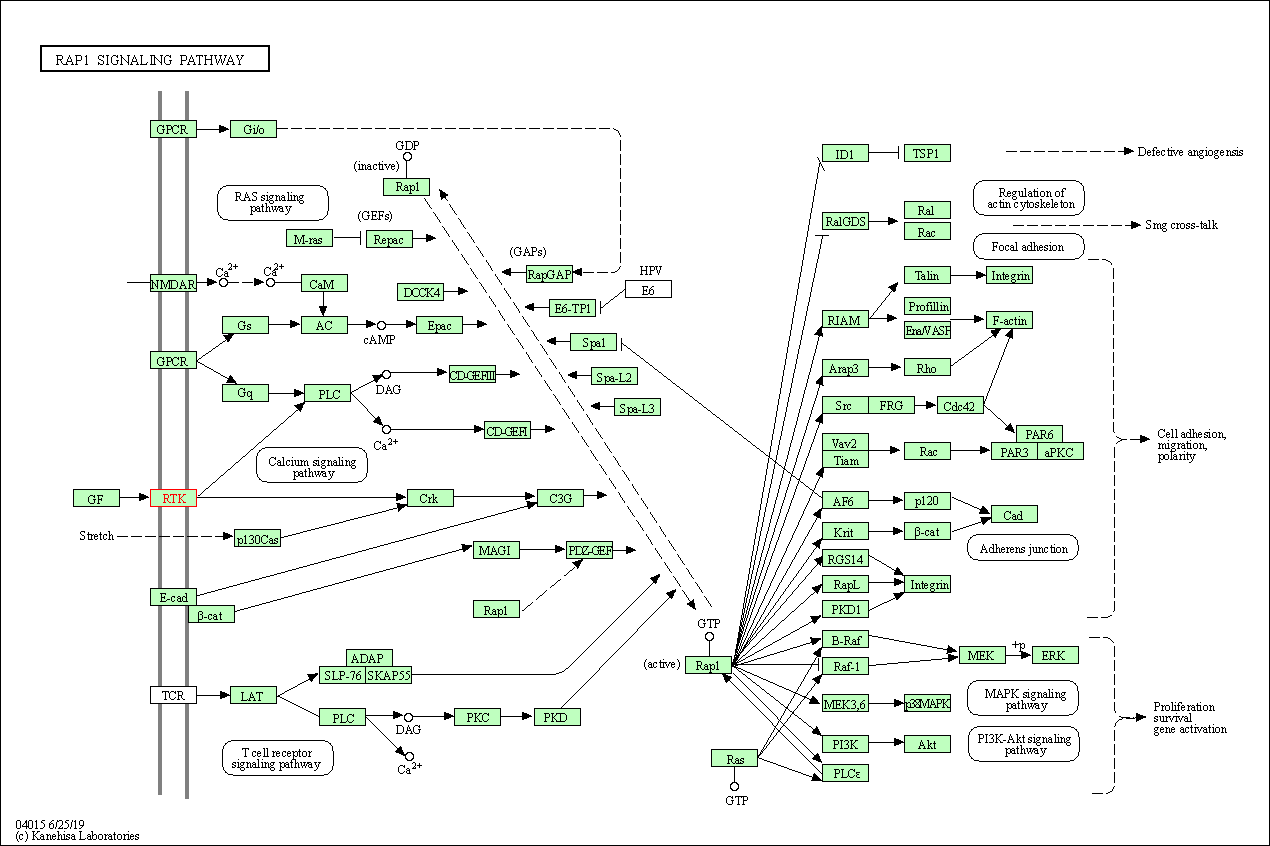
|
| Class: Environmental Information Processing => Signal transduction | Pathway Hierarchy | ||
| Calcium signaling pathway | hsa04020 | Affiliated Target |
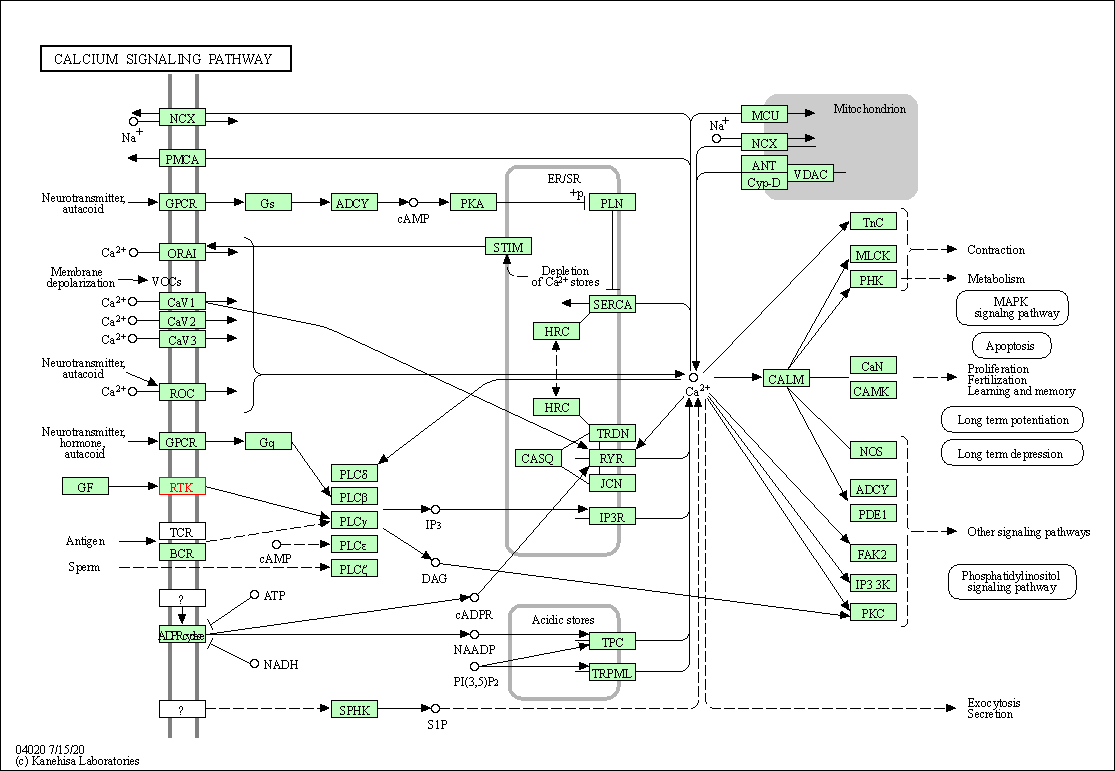
|
| Class: Environmental Information Processing => Signal transduction | Pathway Hierarchy | ||
| Endocytosis | hsa04144 | Affiliated Target |
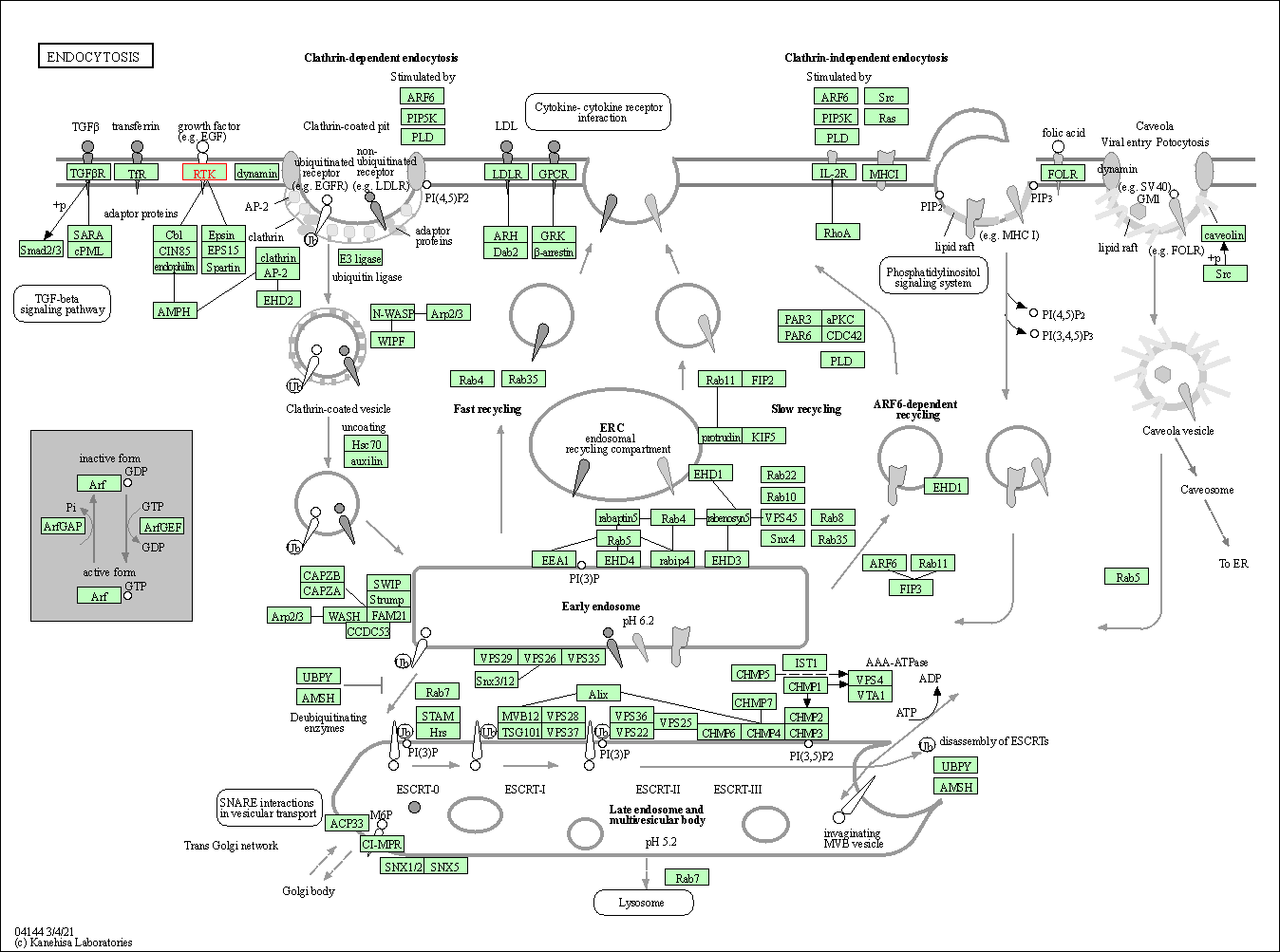
|
| Class: Cellular Processes => Transport and catabolism | Pathway Hierarchy | ||
| PI3K-Akt signaling pathway | hsa04151 | Affiliated Target |
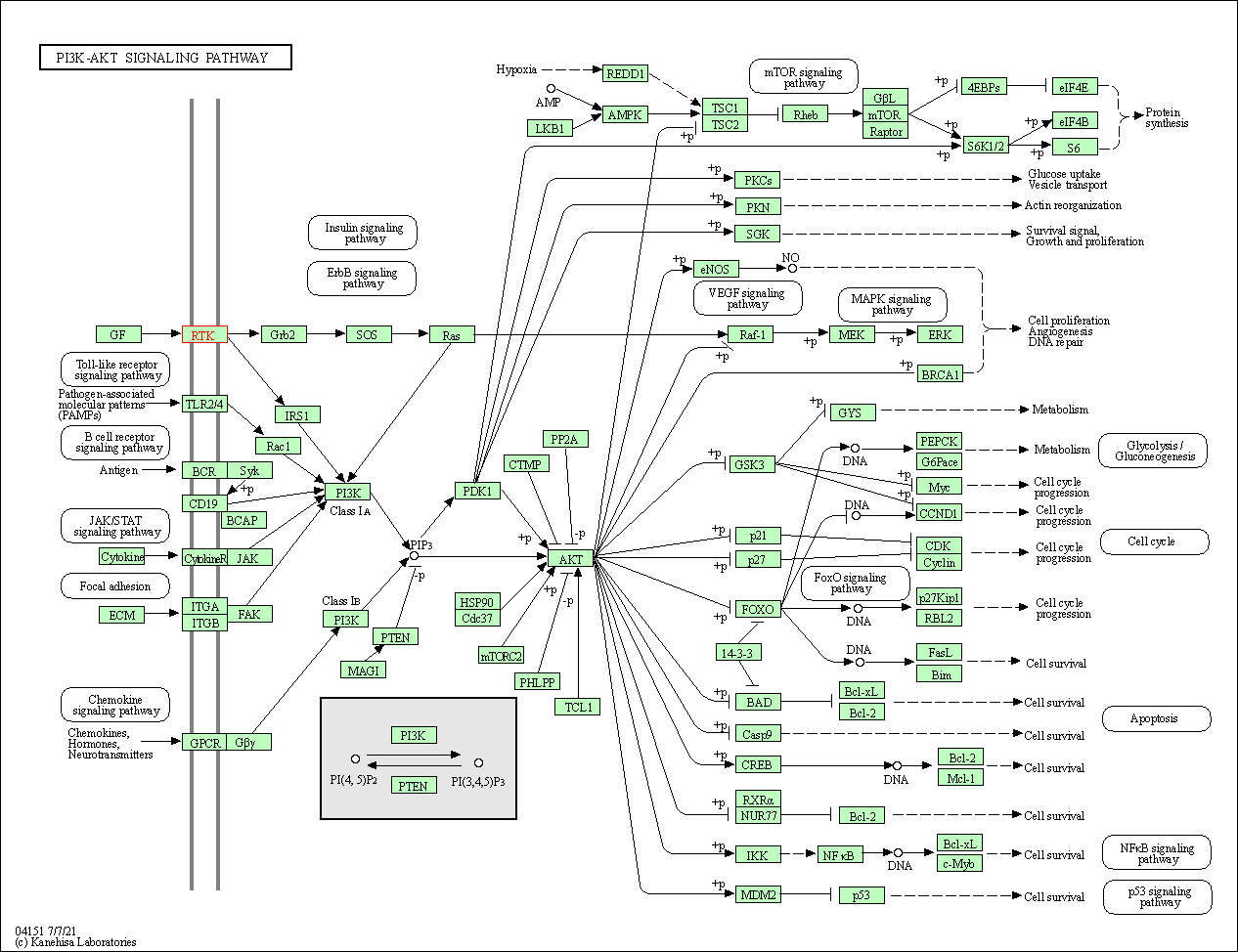
|
| Class: Environmental Information Processing => Signal transduction | Pathway Hierarchy | ||
| Signaling pathways regulating pluripotency of stem cells | hsa04550 | Affiliated Target |
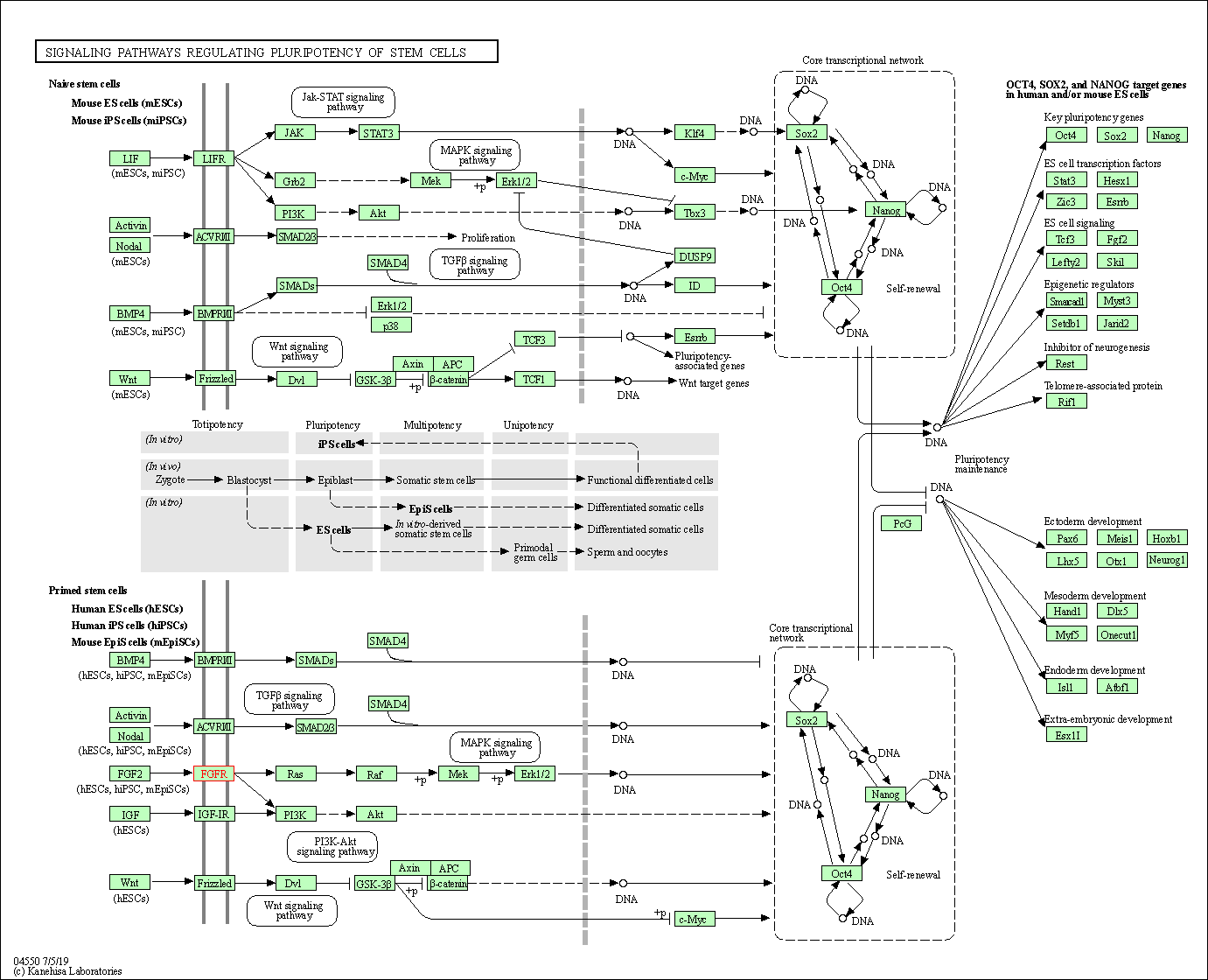
|
| Class: Cellular Processes => Cellular community - eukaryotes | Pathway Hierarchy | ||
| Regulation of actin cytoskeleton | hsa04810 | Affiliated Target |
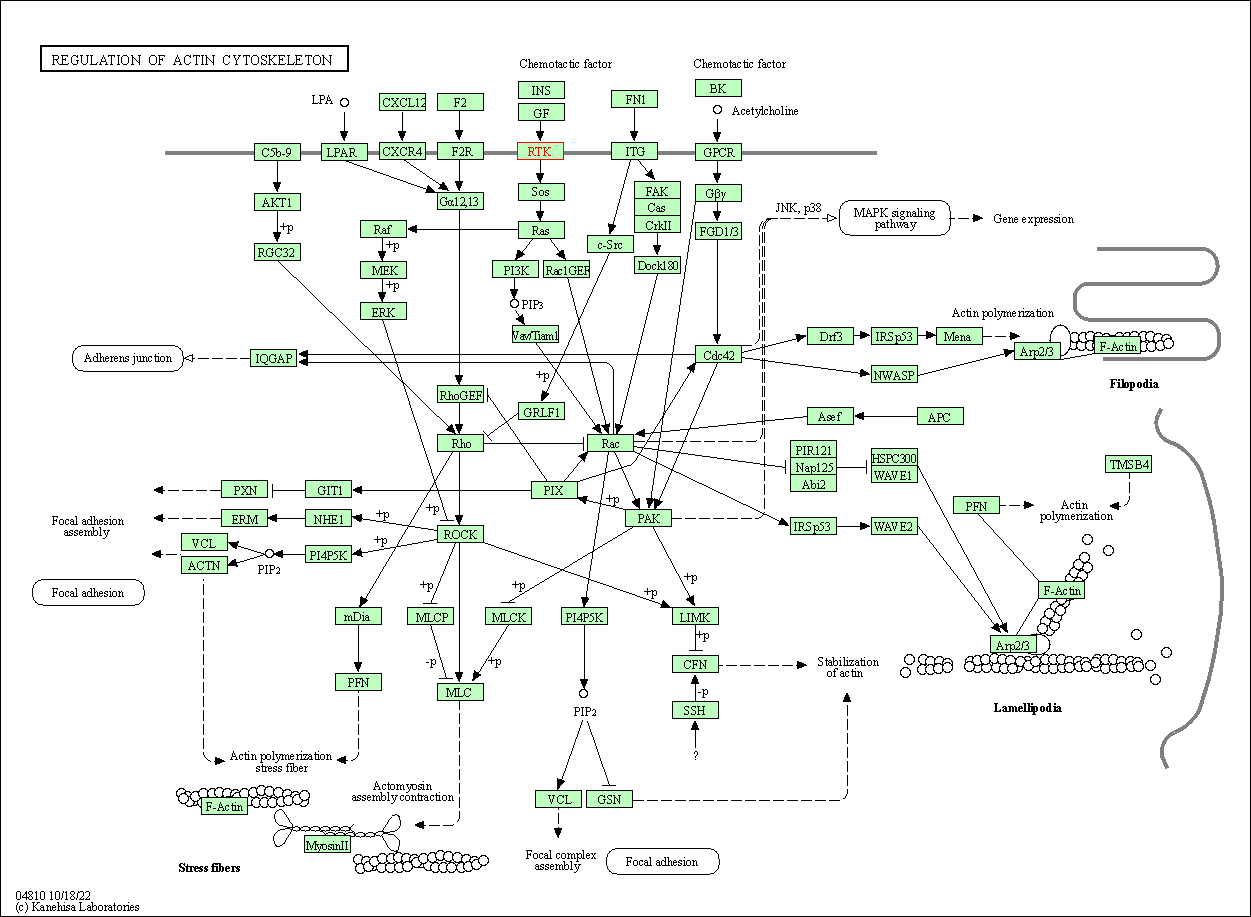
|
| Class: Cellular Processes => Cell motility | Pathway Hierarchy | ||
| Click to Show/Hide the Information of Affiliated Human Pathways | |||
| Degree | 26 | Degree centrality | 2.79E-03 | Betweenness centrality | 1.05E-03 |
|---|---|---|---|---|---|
| Closeness centrality | 2.36E-01 | Radiality | 1.41E+01 | Clustering coefficient | 2.09E-01 |
| Neighborhood connectivity | 4.04E+01 | Topological coefficient | 9.90E-02 | Eccentricity | 12 |
| Download | Click to Download the Full PPI Network of This Target | ||||
| Chemical Structure based Activity Landscape of Target | Top |
|---|---|
| Drug Property Profile of Target | Top | |
|---|---|---|
| (1) Molecular Weight (mw) based Drug Clustering | (2) Octanol/Water Partition Coefficient (xlogp) based Drug Clustering | |
|
|
||
| (3) Hydrogen Bond Donor Count (hbonddonor) based Drug Clustering | (4) Hydrogen Bond Acceptor Count (hbondacc) based Drug Clustering | |
|
|
||
| (5) Rotatable Bond Count (rotbonds) based Drug Clustering | (6) Topological Polar Surface Area (polararea) based Drug Clustering | |
|
|
||
| "RO5" indicates the cutoff set by lipinski's rule of five; "D123AB" colored in GREEN denotes the no violation of any cutoff in lipinski's rule of five; "D123AB" colored in PURPLE refers to the violation of only one cutoff in lipinski's rule of five; "D123AB" colored in BLACK represents the violation of more than one cutoffs in lipinski's rule of five | ||
| Co-Targets | Top | |||||
|---|---|---|---|---|---|---|
| Co-Targets | ||||||
| Target Poor or Non Binders | Top | |||||
|---|---|---|---|---|---|---|
| Target Poor or Non Binders | ||||||
| Target Regulators | Top | |||||
|---|---|---|---|---|---|---|
| Target-regulating microRNAs | ||||||
| Target-interacting Proteins | ||||||
| Target Profiles in Patients | Top | |||||
|---|---|---|---|---|---|---|
| Target Expression Profile (TEP) | ||||||
| Drug Resistance Mutation (DRM) | ||||||
| Target-Related Models and Studies | Top | |||||
|---|---|---|---|---|---|---|
| Target Validation | ||||||
| References | Top | |||||
|---|---|---|---|---|---|---|
| REF 1 | Keratinocyte growth factor. Expert Opin Biol Ther. 2009 Jun;9(6):779-87. | |||||
| REF 2 | Natural products as sources of new drugs over the last 25 years. J Nat Prod. 2007 Mar;70(3):461-77. | |||||
| REF 3 | URL: http://www.guidetopharmacology.org Nucleic Acids Res. 2015 Oct 12. pii: gkv1037. The IUPHAR/BPS Guide to PHARMACOLOGY in 2016: towards curated quantitative interactions between 1300 protein targets and 6000 ligands. (Ligand id: 6954). | |||||
| REF 4 | Emerging drugs for chemotherapy-induced mucositis. Expert Opin Emerg Drugs. 2008 Sep;13(3):511-22. | |||||
| REF 5 | Drugs@FDA. U.S. Food and Drug Administration. U.S. Department of Health Human Services. 2020 | |||||
| REF 6 | URL: http://www.guidetopharmacology.org Nucleic Acids Res. 2015 Oct 12. pii: gkv1037. The IUPHAR/BPS Guide to PHARMACOLOGY in 2016: towards curated quantitative interactions between 1300 protein targets and 6000 ligands. (Ligand id: 7649). | |||||
| REF 7 | ClinicalTrials.gov (NCT02135107) A Double-blind Comparative Study of the Efficacy and Safety of E3810 10mg Once and Twice Daily in Maintenance Therapy for PPI Resistant Gastroesophageal Reflux Disease Patients. U.S. National Institutes of Health. | |||||
| REF 8 | Emerging drugs for diabetic foot ulcers. Expert Opin Emerg Drugs. 2006 Nov;11(4):709-24. | |||||
| REF 9 | ClinicalTrials.gov (NCT03834220) Basket Trial in Solid Tumors Harboring a Fusion of FGFR1, FGFR2 or FGFR3- (FUZE Clinical Trial). U.S. National Institutes of Health. | |||||
| REF 10 | URL: http://www.guidetopharmacology.org Nucleic Acids Res. 2015 Oct 12. pii: gkv1037. The IUPHAR/BPS Guide to PHARMACOLOGY in 2016: towards curated quantitative interactions between 1300 protein targets and 6000 ligands. (Ligand id: 8104). | |||||
| REF 11 | ClinicalTrials.gov (NCT01212107) A Study of LY2874455 in Patients With Advanced Cancer. U.S. National Institutes of Health. | |||||
| REF 12 | URL: http://www.guidetopharmacology.org Nucleic Acids Res. 2015 Oct 12. pii: gkv1037. The IUPHAR/BPS Guide to PHARMACOLOGY in 2016: towards curated quantitative interactions between 1300 protein targets and 6000 ligands. (Ligand id: 7643). | |||||
| REF 13 | ClinicalTrials.gov (NCT00107237) AEE788 and Everolimus in Treating Patients With Recurrent or Relapsed Glioblastoma Multiforme. U.S. National Institutes of Health. | |||||
| REF 14 | MK-2461, a novel multitargeted kinase inhibitor, preferentially inhibits the activated c-Met receptor. Cancer Res. 2010 Feb 15;70(4):1524-33. | |||||
| REF 15 | ClinicalTrials.gov (NCT04071184) Study of Alofanib in Patients With Metastatic Gastric Cancer. U.S. National Institutes of Health. | |||||
| REF 16 | ClinicalTrials.gov (NCT01881217) First-in-man Dose Escalation Study of BAY1179470 in Patients With Advanced, Refractory Solid Tumors. U.S. National Institutes of Health. | |||||
| REF 17 | ClinicalTrials.gov (NCT04526106) First-in-Human Study of Highly Selective FGFR2 Inhibitor, RLY-4008, in Patients With ICC and Other Advanced Solid Tumors. U.S. National Institutes of Health. | |||||
| REF 18 | Trusted, scientifically sound profiles of drug programs, clinical trials, safety reports, and company deals, written by scientists. Springer. 2015. Adis Insight (drug id 800014130) | |||||
| REF 19 | DrugBank: a knowledgebase for drugs, drug actions and drug targets. Nucleic Acids Res. 2008 Jan;36(Database issue):D901-6. | |||||
| REF 20 | E-3810 is a potent dual inhibitor of VEGFR and FGFR that exerts antitumor activity in multiple preclinical models. Cancer Res. 2011 Feb 15;71(4):1396-405. | |||||
| REF 21 | Clinical pipeline report, company report or official report of the Pharmaceutical Research and Manufacturers of America (PhRMA) | |||||
| REF 22 | Company report (Eli Lilly) (drug: LY2874455) | |||||
| REF 23 | A comparison of physicochemical property profiles of marketed oral drugs and orally bioavailable anti-cancer protein kinase inhibitors in clinical development. Curr Top Med Chem. 2007;7(14):1408-22. | |||||
| REF 24 | Corrigendum to 'Targeting FGFR2 with alofanib (RPT835) shows potent activity in tumour models' [Eur J Cancer 61 (2016) 20-28]. Eur J Cancer. 2017 Jan;70:156. | |||||
| REF 25 | National Cancer Institute Drug Dictionary (drug id 751593). | |||||
| REF 26 | Clinical pipeline report, company report or official report of Relay Therapeutics. | |||||
| REF 27 | Pyrido[2,3-d]pyrimidin-7-one inhibitors of cyclin-dependent kinases. J Med Chem. 2000 Nov 30;43(24):4606-16. | |||||
| REF 28 | URL: http://www.guidetopharmacology.org Nucleic Acids Res. 2015 Oct 12. pii: gkv1037. The IUPHAR/BPS Guide to PHARMACOLOGY in 2016: towards curated quantitative interactions between 1300 protein targets and 6000 ligands. (Target id: 1809). | |||||
| REF 29 | A short peptide domain of platelet factor 4 blocks angiogenic key events induced by FGF-2. FASEB J. 2001 Mar;15(3):550-2. | |||||
| REF 30 | Biological evaluation of a multi-targeted small molecule inhibitor of tumor-induced angiogenesis. Bioorg Med Chem Lett. 2006 Apr 1;16(7):1950-3. | |||||
| REF 31 | Discovery of [7-(2,6-dichlorophenyl)-5-methylbenzo [1,2,4]triazin-3-yl]-[4-(2-pyrrolidin-1-ylethoxy)phenyl]amine--a potent, orally active Src kinas... Bioorg Med Chem Lett. 2007 Feb 1;17(3):602-8. | |||||
| REF 32 | A molecular brake in the kinase hinge region regulates the activity of receptor tyrosine kinases. Mol Cell. 2007 Sep 7;27(5):717-30. | |||||
If You Find Any Error in Data or Bug in Web Service, Please Kindly Report It to Dr. Zhou and Dr. Zhang.

